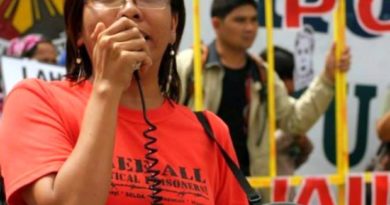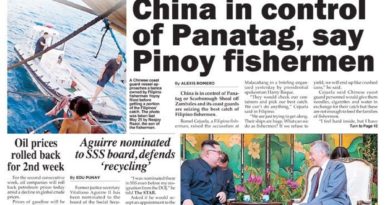HEADLINE-ASIA GEOPOLITICS | China: Stop projecting Beijing as ‘threat’ to Philippine-PH
FILE PHOTO: Philippine Ambassador to the U.S. Jose Manuel Romualdez speaks during a U.S. Trade and Development Agency Offshore Wind Grant Signing at Ayala Triangle Gardens in Manila, Philippines, August 6, 2022. Andrew Harnik/Pool via REUTERS/File Photo
.

China on Sunday called on the Philippines to stop projecting Beijing as a “threat” to the Philippines, maintaining that it has always been “committed” to peace in handling territorial disputes in the South China Sea.
The Chinese Embassy in Manila issued the statement in response to remarks by Philippine Ambassador to Washington Jose Manuel Romualdez during a diplomatic gathering on Feb. 28. He said that while the United States sees both the South China Sea issue and a potential Taiwan conflict as “serious concerns,” he believes the “real flashpoint is the West Philippine Sea,” given “all of these skirmishes happening there.”
Romualdez said the Philippines was facing an “aggression” that was “very real” in its territorial dispute concerning the West Philippine Sea, parts of which have been occupied by China.
But China’s embassy in Manila begged to differ, pointing out that it plays a “major role in maintaining peace in the region and the world,” considering its status as a permanent member of the United Nations Security Council.
“China has always been committed to properly handling the South China Sea disputes with relevant parties through dialogue and consultation, while firmly safeguarding its territorial sovereignty and maritime rights and interests,” said Counselor Ji Lingpeng, who spoke for the Chinese Embassy in Manila.

READ: Beijing warns Manila to ‘act with caution’ after maritime clashes
He also slammed Romualdez’s remarks as “deplorable” and a “baseless accusation,” and branded his statements “Sinophobia remarks.”
“Who [is] stirring up the situation in the South China Sea? Who [is] spreading [the] ‘China threat’? Who [is] ganging up in small blocks (sic)? Who invented ‘economic coercion’? Where did it originate? Who weaponizes economic power and gets addicted to sanctions? The questions are self-explanatory,” read the remarks of Ji, a copy of which was provided by the Chinese Embassy to Filipino journalists.
“Bringing in outside forces and forming ‘small circles’ will not help resolve disputes in the South China Sea, but [will] only complicate the regional situation, undermine regional peace and stability, and backfire on its own security,” it said.
“We urge [Romualdez] to stop spreading erroneous ‘China threat’ and ‘Sinophobia’ remarks, refrain from serving as [a] mouthpiece for another country and do more for the benefit of his own people and his country’s relations with China instead,” the statement added.

Maritime incidents
Beijing and Manila have traded sharp accusations over a slew of maritime incidents in the West Philippine Sea.
But the Chinese Embassy had countered that peace and development were the “common aspirations” of countries within the region and that the economic and trade cooperation between Manila and Beijing has already brought “tremendous benefits to both countries.”
China claims almost the entire South China Sea, a conduit for more than $3 trillion of annual shipborne commerce, including parts claimed by the Philippines, Vietnam, Indonesia, Malaysia and Brunei. The Permanent Court of Arbitration in 2016 said China’s claims had no legal basis.
Constant sightings of Chinese vessels within the Philippines’ exclusive economic zone (EEZ), more specifically over Ayungin (Second Thomas) Shoal, have been reported by the military and the coast guard last year.
Most of these incidents involved blocking and issuing challenges to Philippine vessels on their way to resupply Filipino troops stationed at Ayungin Shoal, where the dilapidated BRP Sierra Madre has been grounded since 1999 to serve as the country’s outpost.
These incidents have been condemned by international allies of the Philippines, including the United States.
![]()

Benham Rise incursion
The latest incursion incident involved two Chinese research vessels spotted “loitering” at Philippine (Benham) Rise last week, which, according to Philippine Navy spokesperson for the West Philippine Sea Commodore Roy Trinidad, were already out of the country’s EEZ by Sunday.
The vessels were monitored out of the country’s EEZ as of Saturday afternoon, he said on dzBB radio.
Maritime security expert Ray Powell said in a social media post on Friday that the Chinese vessels—Haiyang Dizhi Liuhao and Haiyang Dizhi Shihao—left port at Longxue Island in Guangzhou on Feb. 26, sailed east southeast through the Luzon Strait, and were located in the northeast corner of Philippine Rise.
Trinidad said the Naval Forces Northern Luzon was supposed to launch an air surveillance flight earlier to check, but this was hampered by bad weather.
They had yet to confirm the type of ships spotted at Philippine Rise on the next attempt of a reconnaissance flight, but he later told the Inquirer that he believed the vessels were not conducting surveys during their stay within the EEZ.
The ships had a general speed of 8.5 to 10 knots throughout their voyage, he said.
![]()

Extended continental shelf
Larger than Luzon island, the seismically active undersea region extends eastward off the provinces of Aurora and Isabela, and Bicol Region. The extended continental shelf (ECS) has an area of 135,506 square kilometers (13.5 million hectares), equivalent to about half of the country’s land area.
The United Nations Commission on the Limits of the Continental Shelf ruled in 2012 that the rise was part of the country’s ECS and thus the country could explore, exploit, conserve and manage natural resources there.
Philippine Rise is a massive formation of basalt, a common volcanic rock, that has been shown to have natural gas deposits and manganese nodules that are vital to the production of steel.
The landmass, the shallowest part of which is 50 meters, is a rich fishing ground for fisherfolk from Aurora and Quezon, as well as the Bicol provinces.

.
It is called “Kalipungawan” (loneliness) by fishers from Catanduanes, who can reach the area after a 12-hour boat ride. —WITH REPORTS FROM FRANCES MANGOSING, REUTERS AND INQUIRER RESEARCH INQ
.


 Memento Maxima Digital Marketing
Memento Maxima Digital Marketing







